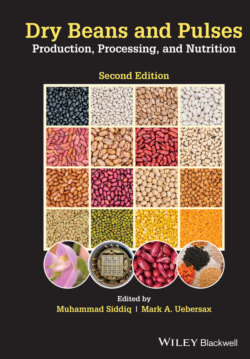Читать книгу Dry Beans and Pulses Production, Processing, and Nutrition - Группа авторов - Страница 89
POSTHARVEST STORAGE QUALITY
ОглавлениеDry bean storage damage and contamination must be minimized through the use of good handling practices. The established standards for food handling are important to sanitary control and defined lot identity. The use of good agricultural practices (GAPs), good manufacturing practices (GMPs), and a broad range of advanced food quality and food safety standards and programs are applied in dry bean handling including ISO 9000, HACCP (hazard analysis critical control points), and SQF (safe quality food) (Uebersax and Siddiq 2012).
As stated previously, the impact of high‐moisture beans or localized moisture that migrates throughout the beans will cause significant mold growth, respiratory heating, and seed darkening within the bean lot. This condition is commonly termed as musty‐moldy beans or bin‐burned beans. Storage‐damaged beans may vary in color, ranging from slightly discolored to a deep chocolate‐brown color and also possess mold mycelia and strong musty off‐flavors (musty, moldy, sour, bitter, or “fishy”). Frequently, moisture migration that has not been adequately dissipated through aeration in the storage bin will result in localized pockets of beans of high moisture content and subsequent mold growth. The uppermost sections of a long‐term storage bin are most susceptible to this rising moisture vapor, its condensation, and the subsequent mold development. Typically, this condition manifests as a solid clumped mass of beans and is characterized as “severely damaged beans” during storage. This damaged bean mass causes significant quality deterioration if not carefully segregated and removed (Uebersax and Siddiq 2012).
The musty off‐flavor that develops in stored dry beans is partially attributed to the bi‐phenol compound, geosmin – an oxygenated hydrocarbon (trans‐1,10‐di methyl‐trans9‐decalol) (Buttery et al. 1976; Roland et al. 2017). Swanson and Hernandez (1984) reported that geosmin and 2‐methylisoborneol (MIB) are microbial metabolites associated with the earthy, musty off‐flavors in dry beans. The presence of part per billion (ppb) concentrations of contaminating volatile compounds in dry beans can result in objectionable off‐flavors since the flavor of dry beans is bland. The growth of Actinomyces produces both geosmin and MIB on beans or in the water supply used during bean cultivation and may result in production of a musty off‐flavor in processed dry beans and other food products. Fairley (2007) detected geosmin in navy beans spiked with A. flavus, P. commune, and P. expansum after three days of incubation. Concentrations increased during incubation and with increased mold counts and geosmin and 2‐MIB were identified as the musty‐odor compounds associated with moldy navy beans during processing.
Further, seed moisture content, storage temperature, and duration of storage each directly influence bean quality and are thus important factors to consider during dry bean storage (Nasar‐Abbas et al. 2009; Rani et al. 2013).
